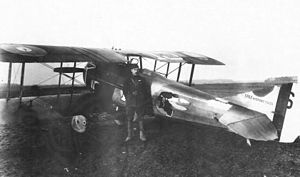93d Aero Squadron
| 93d Aero Squadron | |
|---|---|

93d Aero Squadron – SPAD XIII, Foucaucourt Airdrome, France, November 1918
|
|
| Active | 21 August 1917 – 31 March 1919 |
| Country |
|
| Branch |
|
| Type | Squadron |
| Role | Pursuit |
| Part of | American Expeditionary Forces (AEF) |
| Fuselage Code | "Indian Head" |
| Engagements |
World War I |
| Commanders | |
| Notable commanders |
Maj. Jean Huffer Capt. Charles Rockwell |
| Insignia | |
| 93d Aero Squadron Emblem (approved by AEF 18 November 1918) |  |
| Aircraft flown | |
| Fighter |
SPAD VII, 1918 SPAD XIII, 1918 |
| Service record | |
|---|---|
| Operations |
3d Pursuit Group
|
| Victories |
Air Aces: 3
|
3d Pursuit Group
Western Front, France: 14 August-11 November 1918
Air Aces: 3
The 93d Aero Squadron was a Air Service, United States Army unit that fought on the Western Front during World War I.
The squadron was assigned as a Day Pursuit (Fighter) Squadron as part of the 3d Pursuit Group, First United States Army. Its mission was to engage and clear enemy aircraft from the skies and provide escort to reconnaissance and bombardment squadrons over enemy territory. It also attacked enemy observation balloons, and perform close air support and tactical bombing attacks of enemy forces along the front lines. After the 1918 Armistice with Germany, the squadron returned to the United States in March 1919 and was demobilized.
The current United States Air Force unit which holds its lineage and history is the 93d Bomb Squadron, assigned to the 307th Operations Group at Barksdale Air Force Base, Louisiana.
The squadron was initially formed in early August 1917 at Jefferson Barracks, Missouri, where 150 civilians were sworn into the United States Army as soldiers. The newly-sworn in men were sent to Kelly Field, Texas, where they arrived on 19 August and were organized as the 95th Aero Squadron. Initially, the squadron was trained in close order drill and other basic training into the Army. After six weeks of indoctrination, the squadron was ordered for overseas duty, moving to Hazelhurst Field#2, Garden City, Long Island on 13 October.
On 15 October the troops were boarded onto the former British Cunard liner RMS Pannonia, and after an uneventful voyage embarked at the port of Liverpool, England on 29 October. From there, the squadron was moved to Camp Sorden and placed under the control of the British Royal Flying Corps (RFC) for training. At Sorden, the squadron was divided into flights for instruction in the technical aspects of maintaining aircraft and operating a squadron. Over the next several months they trained diligently, and on 1 May, the squadron was re-assembled at RFC Beaulier for organization as a trained unit. After several more weeks of final training by the RFC, the squadron was ordered to France on 1 June, and moved to the Flower Down Rest Camp, Winchester.
...
Wikipedia
